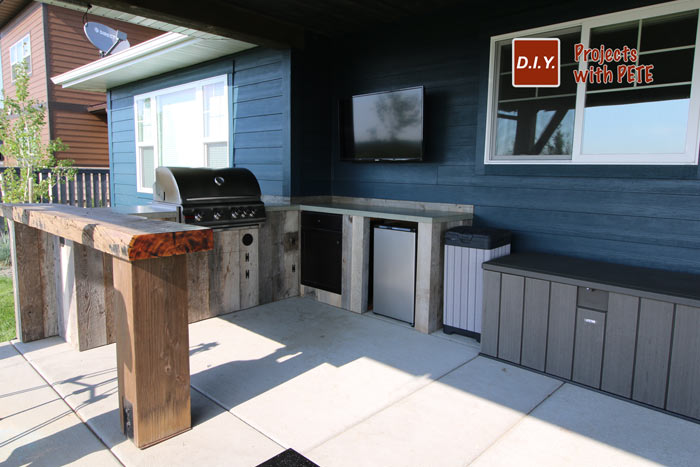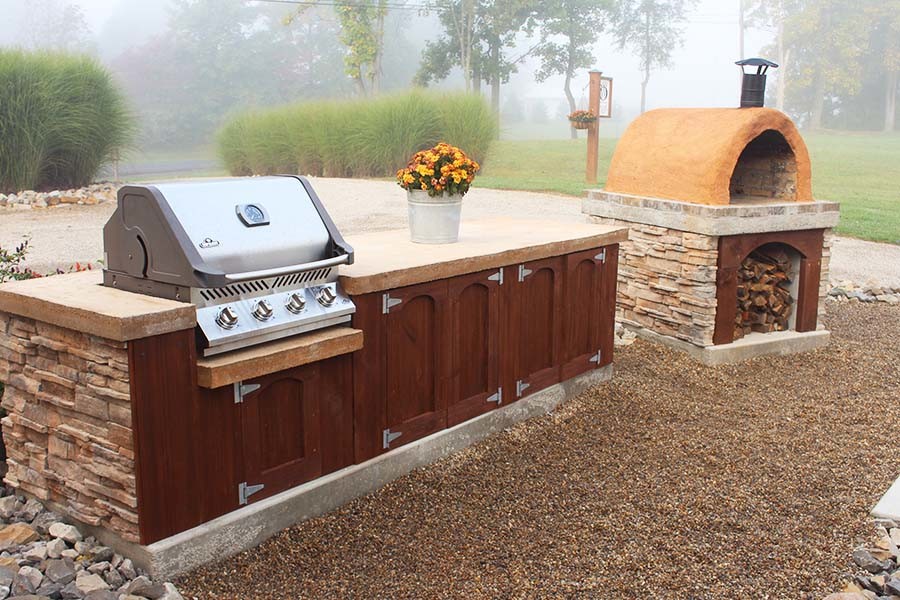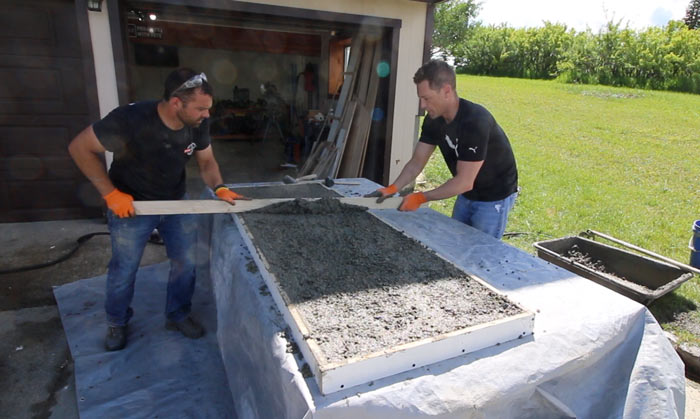Building an Outdoor Concrete Countertop
Outdoor concrete countertops offer a durable and customizable surface for your outdoor kitchen or barbecue area. With the right materials, tools, and techniques, you can build a beautiful and functional concrete countertop that withstands the elements and complements your outdoor space. In this comprehensive guide, we’ll walk you through the process of building an outdoor concrete countertop, from preparing the mold and mixing the concrete to finishing and sealing the surface.

Planning and Preparation
Before you begin building your outdoor concrete countertop, it’s essential to plan and prepare adequately:
Design: Decide on the size, shape, and design of your countertop, taking into account the layout of your outdoor kitchen or cooking area. Consider factors such as the location of appliances, sinks, and other features, as well as any special considerations for outdoor use.
Materials: Gather the necessary materials for building the countertop, including concrete mix, reinforcing mesh or fibers, mold release agent, and any decorative additives or pigments you plan to use. Additionally, you’ll need basic tools such as a mixing bucket, trowels, and floats.
Mold Construction: Construct a sturdy mold for the countertop using melamine or plywood. The mold should be the exact size and shape of the desired countertop and include any cutouts or features for sinks, appliances, or accessories. Seal the inside of the mold with a mold release agent to facilitate easy removal of the cured concrete.

Mixing and Pouring Concrete
Once you have prepared the mold, it’s time to mix and pour the concrete:
Concrete Mix: Follow the manufacturer’s instructions to mix the concrete to the desired consistency. Consider adding reinforcing mesh or fibers to the mix for added strength and durability, especially for larger countertops or areas with heavy use.
Pouring: Carefully pour the mixed concrete into the prepared mold, ensuring even distribution and filling any corners or edges. Use a vibrating tool or rubber mallet to eliminate air bubbles and settle the concrete into place.
Finishing: Smooth the surface of the wet concrete with a trowel, ensuring it is level and free of imperfections. You can also add decorative elements or aggregates to the surface at this stage for a custom look.

Curing and Finishing
After pouring the concrete, allow it to cure and finish the surface:
Curing: Cover the countertop with plastic sheeting or a curing blanket to retain moisture and promote proper curing. The curing process typically takes several days, during which time the concrete gains strength and durability.
Grinding and Polishing: Once the concrete has cured, remove the mold and use a grinder with diamond polishing pads to smooth and polish the surface. Start with a coarse grit pad and gradually work your way up to finer grits for a smooth, glossy finish.
Sealing: Apply a high-quality concrete sealer to the finished countertop to protect it from stains, moisture, and UV damage. Choose a sealer specifically designed for outdoor use and follow the manufacturer’s instructions for application and curing.

Installation and Maintenance
Finally, install the finished concrete countertop in your outdoor kitchen or cooking area:
Installation: Place the countertop on a sturdy base or cabinet structure, ensuring it is level and securely anchored in place. Connect any plumbing fixtures or appliances as needed, following standard installation procedures.
Maintenance: To keep your outdoor concrete countertop looking its best, clean it regularly with a mild detergent and water. Avoid using abrasive cleaners or tools that can scratch or damage the surface. Additionally, reapply the sealer as needed to maintain protection and prolong the life of the countertop.

Common Mistakes to Avoid
When building an outdoor concrete countertop, avoid these common mistakes:
Inadequate Mold Preparation: Failing to properly seal the inside of the mold can result in difficulty removing the cured concrete or unsightly marks on the surface.
Overworking the Concrete: Overmixing or overworking the concrete can lead to air bubbles, uneven distribution, and poor adhesion to the mold, resulting in a flawed finished product.
Improper Curing: Inadequate curing can compromise the strength and durability of the concrete countertop. Ensure proper moisture retention and follow recommended curing times and procedures.
Skipping Surface Preparation: Neglecting to properly prepare and finish the surface of the cured concrete can result in rough or uneven areas that detract from the appearance and usability of the countertop.

How long does it take to build an outdoor concrete countertop?
Building an outdoor concrete countertop is a multi-step process that requires careful planning, preparation, and curing. The exact timeline can vary depending on factors such as the size and complexity of the countertop, the weather conditions, and the curing time required for the concrete. In general, the process can take anywhere from several days to a week or more from start to finish. This includes planning and preparation, mixing and pouring the concrete, curing and finishing the surface, and installation. It’s essential to allow sufficient time for each step to ensure a high-quality finished product that withstands the elements and provides long-lasting durability.
Can I use regular concrete for an outdoor countertop?
While regular concrete can be used for outdoor countertops, it may not offer the same level of durability and performance as specialty concrete mixes designed specifically for countertops. Regular concrete may be more prone to cracking, staining, and weathering when exposed to outdoor conditions such as UV exposure, moisture, and temperature fluctuations. Specialty countertop mixes typically contain additives and aggregates that improve strength, workability, and resistance to environmental factors. When building an outdoor concrete countertop, it’s best to use a high-quality countertop mix formulated for outdoor use to ensure optimal performance and longevity.
Do I need to reinforce the concrete for an outdoor countertop?
Reinforcing the concrete is highly recommended for outdoor countertops to improve strength, durability, and resistance to cracking. Depending on the size and design of the countertop, you can use various reinforcement methods such as adding steel mesh or fibers to the concrete mix. These reinforcements help distribute stress and prevent cracking, especially in larger countertops or areas with heavy use. Additionally, proper reinforcement can enhance the structural integrity of the countertop and prolong its lifespan in outdoor environments where it may be exposed to harsh conditions such as temperature fluctuations and moisture.
How thick should an outdoor concrete countertop be?
The thickness of an outdoor concrete countertop depends on factors such as the size, design, and intended use of the countertop, as well as local building codes and regulations. In general, outdoor concrete countertops are typically poured to a thickness of 2 to 3 inches to provide sufficient strength and durability. However, thicker countertops may be required for larger or more heavily used areas to ensure adequate support and resistance to cracking. It’s essential to consult with a professional or local building authorities to determine the appropriate thickness for your specific project and ensure compliance with applicable codes and standards.
What are the best finishes and sealers for outdoor concrete countertops?
Choosing the right finish and sealer is essential for protecting and enhancing the appearance of outdoor concrete countertops. For outdoor use, it’s recommended to use a high-quality concrete sealer specifically designed for exterior applications. Look for sealers that offer UV protection, weather resistance, and durability to withstand exposure to sunlight, moisture, and temperature fluctuations. Popular sealer options for outdoor concrete countertops include acrylic sealers, epoxy sealers, and polyurethane sealers. Additionally, consider adding a decorative finish or color enhancer to customize the appearance of the countertop and enhance its visual appeal in your outdoor space

Outdoor kitchen construction, concrete counter form

Building an Outdoor Kitchen from Concrete and Stone

How to Make Concrete Counters for an Outdoor Kitchen – DIY Pete

Related articles:
- Cost Of Concrete Countertop Per Square Foot
- Vibrating Table For Concrete Countertops
- Concrete Countertop Coatings
- How To Make Concrete Countertops For Outdoor Kitchens
- Concrete Countertop Edge Profile Forms
- How To Build An Outdoor Concrete Countertop
- Glass In Concrete Countertops
- Concrete Countertops That Look Like Marble
- Concrete Countertops For Kitchens
- Concrete Countertop For Outdoor Kitchen
How To Build An Outdoor Concrete Countertop
Concrete countertops are a popular choice for outdoor kitchens and barbecues. Not only are they durable and hardwearing, but they can also be customized to fit the style of any outdoor space. Building an outdoor concrete countertop is a great DIY project that can be completed in just a few days with the right supplies and tools.
Features of an Outdoor Concrete Countertop
Concrete countertops offer long-lasting durability and are resistant to water, staining, and heat. They also provide a unique look that is customizable to fit any style. Concrete countertops have a smooth, highly polished surface that is easy to clean and maintain. Additionally, they are scratch-resistant and won’t chip or crack like other materials.
Benefits of an Outdoor Concrete Countertop
Concrete countertops offer many functional benefits, including being easy to customize with any style of kitchen or barbeque area. Furthermore, they are low maintenance and require minimal care over time. They are also resistant to water and heat, making them perfect for outdoor use.
Pros and Cons of an Outdoor Concrete Countertop
Pros:
• Durable and long-lasting
• Heat-, water-, and stain-resistant
• Easy to customize
• Low maintenance
• Scratch-resistant
Cons:
• Can be expensive
• Difficult to install without professional help
• Heavy and require additional support for kitchen islands or other large pieces
• Can be difficult to repair if damaged
Installation and Care of an Outdoor Concrete Countertop
Installing an outdoor concrete countertop requires some knowledge of carpentry and building construction. It’s best to hire a professional contractor to ensure that the countertop is installed correctly and safely. Once the countertop is installed, it should be sealed with a specialized concrete sealer to protect it from staining, water damage, and wear and tear. The sealer should be reapplied every few years to maintain its protective qualities. Additionally, concrete countertops should be cleaned regularly with a soft cloth and mild soap. Avoid using abrasive cleaners as they can damage the surface of the concrete.
Where To Buy An Outdoor Concrete Countertop
Outdoor concrete countertops can be purchased from many home improvement stores and online retailers. Before buying, be sure to measure the area where the countertop will go so that you get the correct size for your space. Additionally, it’s important to consider the type of sealer you’ll need for your specific application and make sure it’s included in your purchase.
How much does an outdoor concrete countertop cost?
The cost of an outdoor concrete countertop varies depending on size, design, installation cost, and other factors. Generally speaking, prices range from around $400-$1000 for a standard-sized countertop.
How do I clean an outdoor concrete countertop?
Cleaning an outdoor concrete countertop is easy. Simply use a mild soap and warm water with a soft cloth or sponge. Avoid using abrasive cleaners as they can cause damage to the surface.
How often should I reseal my outdoor concrete countertop?
Resealing your outdoor concrete countertop should be done every 3-5 years depending on usage and exposure to the elements. It’s important to use a specialized concrete sealer designed for outdoor use to protect the surface from staining and water damage.